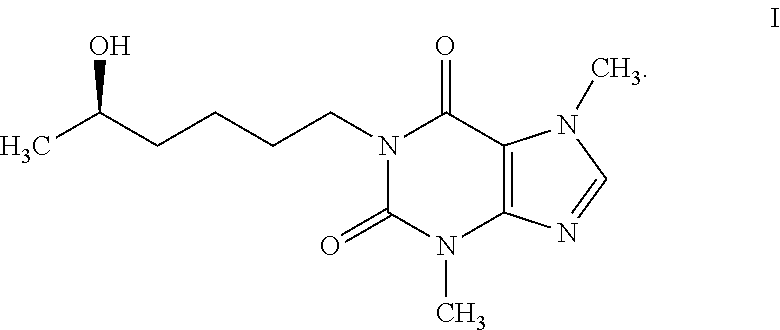Lisofylline analogs and methods for use
a technology of lisofylline and analogs, applied in the field of autoimmune disorders, can solve problems such as limiting clinical development of lisofyllin
- Summary
- Abstract
- Description
- Claims
- Application Information
AI Technical Summary
Benefits of technology
Problems solved by technology
Method used
Image
Examples
example 1
Synthesis of 4-Butoxy-2H-phthalazin-1-one (CPW29) and 4-Butoxy-2-butyl-2H-phthalazin-1-one (CPW30)
[0124]Sodium hydride (60 mg, 95%, 2.4 mmol) was added into a solution of phthalhydrazide (330 mg, 2.0 mmol) in 10 ml anhydrous DMF. After stirring at 0° C. for 30 minutes, 1-bromobutane (0.2 ml, 1.8 mmol) and catalytic amount of tetrabutylammonium iodide were added and the mixture was stirred at room temperature overnight. The reaction was quenched by addition of water and the reaction mixture was extracted with ethyl acetate. The combined extracts were washed with water, saturated aqueous sodium chloride solution, and dried over anhydrous magnesium sulfate. The solvent was removed at reduced pressure. The products were purified by column chromatography (silica, ethyl acetate) to afford CPW29 (30 mg) and CPW30 (25 mg).
[0125]CPW29: 1H NMR (300 MHz, CDCl3) δ 1.01 (t, 3H), 1.53 (sextet, 2H), 1.84 (p, 2H), 4.32 (t, 2H), 7.81 (m, 2H), 8.02 (m, 1H), 8.42 (m, 1H), 10.85 (s, 1H). MS (ESI) m / z 2...
example 2
Synthesis of 4-Ethoxy-2H-phthalazin-1-one (CPW27) and 4-Ethoxy-2-ethyl-2H-phthalazin-1-one (CPW28)
[0127]The title compounds were synthesized via the procedure of Example 1 using bromoethane (0.9 mmol). Yield: CPW27 (25 mg) and CPW28 (30 mg).
[0128]CPW27: 1H NMR (300 MHz, CDCl3) δ 1.48 (t, 3H), 4.38 (q, 2H), 7.02 (m, 2H), 8.03 (m, 1H), 8.43 (m, 1H), 11.01 (s, 1H). MS (ESI) m / z 190.3 [MH]+
[0129]CPW28: 1.39 (t, 3H), 1.48 (t, 3H), 4.18 (q, 2H), 4.38 (q, 2H), 7.75 (m, 2H), 7.99 (m, 1H), 8.40 (m, 1H).
example 3
Synthesis of 4-Hexyloxy-2H-phthalazin-1-one (CPW31) and 2-Hexyl-4-hexyloxy-2H-phthalazin-1-one (CPW32)
[0130]The title compounds were synthesized via the procedure of Example 1 using 1-chlorohexane (1.8 mmol). Yield: CPW31 (25 mg) and CPW32 (27 mg).
[0131]CPW31: 1H NMR (300 MHz, CDCl3) δ 0.91 (t, 3H), 1.37 (m, 4H), 1.49 (p, 2H), 1.84 (p, 2H), 4.31 (t, 2H), 7.81 (m, 2H), 8.02 (m, 1H), 8.43 (m, 1H), 11.11 (s, 1H).
[0132]CPW32: δ 0.87 (t, 3H), 0.91 (t, 3H), 1.32 (m, 8H), 1.46 (m, 4H), 1.81 (m, 4H), 4.10 (t, 2H), 4.28 (t, 2H), 7.74 (m, 2H), 7.94 (m, 1H), 8.38 (m, 1H).
PUM
| Property | Measurement | Unit |
|---|---|---|
| temperature | aaaaa | aaaaa |
| w/w | aaaaa | aaaaa |
| droplet size | aaaaa | aaaaa |
Abstract
Description
Claims
Application Information
 Login to View More
Login to View More - R&D
- Intellectual Property
- Life Sciences
- Materials
- Tech Scout
- Unparalleled Data Quality
- Higher Quality Content
- 60% Fewer Hallucinations
Browse by: Latest US Patents, China's latest patents, Technical Efficacy Thesaurus, Application Domain, Technology Topic, Popular Technical Reports.
© 2025 PatSnap. All rights reserved.Legal|Privacy policy|Modern Slavery Act Transparency Statement|Sitemap|About US| Contact US: help@patsnap.com



